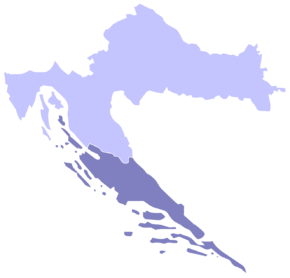Dalmatia is a region on the Croatian Adriatic.


Regions
Counties:

places
- Split - Diocletian's Palace is a UNESCO World Heritage Site
- Zadar - The enchanting old town is located on the peninsula in front of the city at the harbor. The fortifications are a UNESCO World Heritage Site
- Šibenik - Both the Cathedral of St. James and the fortifications are on the UNESCO World Heritage List
- Dubrovnik - the medieval city with its historical center is on the UNESCO World Heritage List
- Kaštela
- Sinj
- Solin
- Okrug Donji
- Omiš
- Knin
- Metković
- Makarska - he gives Makarska Riviera their name, a narrow coastal strip between the Biokovo Karst Mountains and the Adriatic Sea.
- Trogir - the entire old town has been declared a World Heritage Site by UNESCO
- Ploče
- Trilj
- Imotski
- Starigrad Paklenica - in the immediate vicinity is the Paklenica National Park
Islands

- Brač
- Hvar
- Korčula
- Kornati islands - Parts of the archipelago are protected as a national park
- Lastovo
- Lopud
- Mljet
- Murter
- Pag
- Šolta
- Vis
background
language
getting there
By plane
The two largest airports in the region are Dubrovnik and Split. Numerous direct connections from airports in German-speaking countries are offered to both - at least seasonally. The airport has grown in importance in recent years Zadar in northern Dalmatia, here too, various companies offer direct flights from Germany and Switzerland during the summer half-year. It takes about 1:45 hours to fly from Frankfurt to Split and usually pays around € 200 there and back; from Vienna 1:15 hours and 170 €; from Zurich 1½ hours and € 260. A flight from Frankfurt to Dubrovnik takes about 2 hours and normally costs € 300; from Vienna just under 1½ hours and € 200.
By train
Two trains run daily from Zagreb via Ogulin, and three in summer in summer, including a night train with sleeping and couchette cars. The day trains require a reservation. There is a night train (EuroNight) to Zagreb from Munich, Salzburg or Villach (and smaller train stations in between); from Frankfurt a. M./Stuttgart/München/Salzburg/Villach (and a few train stations in between) or from Vienna / Graz there is also a Eurocity to Zagreb once a day; there is also an IC bus from the Munich central bus station. The fastest train connection from Munich to Split takes around 18½ hours; from Vienna (also with one change in Zagreb) just under 15 hours.
By bus
Eurolines offers daily long-distance bus connections from several German cities without changing to Split (with stops in Zadar, Sibenik, Trogir). For example, it takes a good 14 hours from Munich, one way normally costs 74 € (promo prices can be significantly cheaper); from Stuttgart approx. 18 hours (€ 99); from Frankfurt a. M. 22½ hours (114 €).
In the street
The most important traffic axis for individual traffic to Dalmatia is the Croatian A1 motorway (called "Dalmatina"), which begins in Zagreb and runs through most of Dalmatia. Coming from the German-speaking area you drive through Slovenia. Both in Croatia and Slovenia (and of course in Austria) the use of the motorway is subject to tolls. From Vienna to Split, for example, it is 760 kilometers by road, for which you have to plan a pure driving time of just over 7 hours; from Munich 870 kilometers (just under 9 hours). Alternatively, you can also drive along the scenic coastal road on the Adriatic (national road D 8 / "Jadranska Magistrala"), which, however, makes for a delay of over two hours compared to the motorway on the route to Split. However, you can also drive a mix of motorway and coastal road, so that you only "lose" an hour, for example, but gain many beautiful views of the coast and the sea.
When traveling to the Dubrovnik area it should be noted that this is a Croatian exclave that can only be reached by land Bosnia Herzegovina can be reached. Although you only drive 9 kilometers across the territory of this state, you have to cross the EU's external border twice each time, with appropriate passport and customs controls. A transit highway to Dubrovnik, the use of which would not count as entry into Bosnia-Herzegovina, is still in the planning stage. The passage through Bosnia-Herzegovina can be avoided using the Ploče - Trpanj ferry connection.
By bicycle
The European long-distance cycle route runs along the entire length of the Dalmatian coast Eurovelo 8 (Mediterranean Sea).
mobility
Tourist Attractions
- Dubrovnik is mainly visited because of its beautiful old town, which is a UNESCO World Heritage Site.
- In front of the city walls of Dubrovnik is the impressive one Fort Lovrijenac.
activities
kitchen
nightlife
security
climate
literature
- Baedeker Croatian Adriatic Coast Dalmatia
